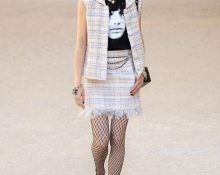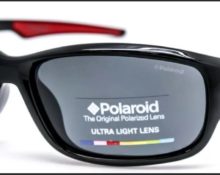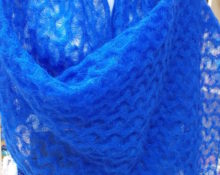The material owes its non-standard name to a unique painting technique. Painting is carried out on various canvases of artificial, vegetable or combined origin. The effect of degradation in clothing is a smooth transition from one color to another. The essence of the method is reminiscent of hair coloring using the ombre technique. In other words, a gradient is formed by using a special technique. Initially, it may seem that the fabric has faded under bright sunlight or has suffered from improper washing. But if you take a closer look, you will notice an elegant, beautiful transition made with the help of professional equipment.
Degrade fabric - what is it?
The method can be used on various canvases. A beautiful transition can be obtained from one color or two tones. The gradient type can also be selected. Tones can replace each other horizontally, vertically, and shimmer from the center to the edges of the product.
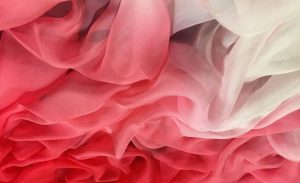
The technique first appeared in the seventies. Its ancestors were hippies who independently achieved a delightful effect.They twisted and tied things, then dipped them in dye. The famous bleached jeans, popular in the eighties, were created using a similar technique. Drawings were applied to denim, then the fabric was specially bleached in different ways.
For some time, degradation in clothing ceased to be used. Now the gradient is back in fashion. Degrade can combine completely opposite colors. The name of the style comes from the English language, where it means transition.
Degrade - fabric with gradient, composition
Various materials can be used to create a gradient. It is best to create a beautiful iridescence on the following fabrics:
- Synthetic fabrics. The advantage is the low price of synthetics with a degrading effect. Such fabrics are based on supplex, nylon, spandex and polyester fibers.
- Woolen material. The degrade style looks great on woolen items. The fabric retains heat very well, so hats, sweaters, turtlenecks, scarves and mittens are often made from degrade wool.
- Viscose. This material is color fast. It forms the basis for the production of knitted fabrics with a gradient overflow.
- Silk fabrics. Degrade looks luxurious due to the natural shine of silk. The overflow turns out shining. This is an ideal solution for evening dresses, curtains and other things.
- Cotton fabrics. Environmentally friendly, natural material is beautifully dyed. To create shimmering degrade, a knitted or woven fabric is suitable.
The gradient can be applied in various ways. There are three options in total:
- Layering technique. Colors of different shade intensities are gradually layered onto fabric of the same tone.
- Printing technique.The optimal method of painting if it is necessary to process not the entire thing, but to make an image on a single-color material.
- Basic technique. One shade is used. At the top the canvas retains a light or white color, towards the bottom the material becomes bright.
The gradient looks great on formal, elegant dresses and blouses. It is used to create beach suits - swimsuits, pareos, capes. In the interior, degrade is used for coloring curtains, tablecloths, and bedding.
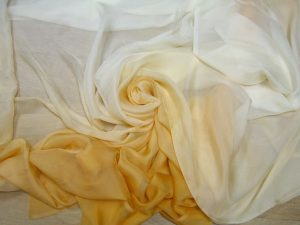
Degrade drawing - pros and cons of ombre
Fabric with an ombre effect has a number of advantages:
- environmentally friendly material;
- used in various fields;
- there is a wide range of fabrics on which you can make a gradient;
- looks elegant and expensive;
- allows you to create exclusive things;
- Suitable for evening and everyday wear.
One of the disadvantages is the need for careful care. If the dye is of poor quality, the item will quickly lose color. Therefore, it is important to be careful when choosing a product for dyeing fabric.
Fabric with degradable effect - care rules
Self-dyed fabric requires delicate care. Principles of working with degradable materials:
- Wash at a temperature of no more than thirty degrees, you can use cold water for washing.
- Hand wash recommended.
- The fabric can be washed in a washing machine on a delicate cycle.
- Before drying, turn the product inside out.
- Limit sunlight exposure to the product.
- Ironing through a damp piece of fabric on the reverse side, steaming is allowed.
If the gradient is applied to knitwear or cotton, the products can simply be soaked in a soapy solution.To remove stains from degraded silk or satin, you will have to use dry cleaning services.


 0
0